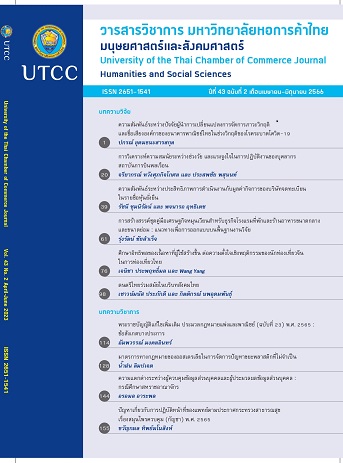Creating Circular Economy Toolkit for SMEs in the Accommodation and Restaurant Businesses: A Research-Based Design
Main Article Content
Abstract
This applied research is an evidence-based approach employing a qualitative method. It is aimed to investigate the interests and desires of the accommodation and restaurant SMEs relating to an effective circular economy toolkit. An individual in-depth interview is conducted to collect data from 23 key informants, representing owners and/or top management of SMEs located in the coastal provinces of Thailand. Descriptive analysis is executed in accordance with media and design elements for the circular economy toolkit. Results revealed that: (1) CE toolkit must place emphasis on execution, be realistic and providing guidelines that can be implemented in SMEs’ businesses. (2) The media set must include video clips as the major tool. Booklets might be utilized as supplementary, along with infographic poster for CE execution spots. (3) Content and presentation style must be easy to follow, attractive and practical in real business situations. Since two main types of surplus materials and wastes mainly generated in this business sector involves food and plastic, it is, thus, suggested to make contents clear, easy, and precise by separating subjects into sub-sections. Finally, the researcher synthesizes findings to propose a pragmatic approach for creating a toolkit set for driving circular economy practices among the targeted SMEs.
Article Details

This work is licensed under a Creative Commons Attribution-NonCommercial-NoDerivatives 4.0 International License.
ลิขสิทธิ์ของบทความ
ผลงานที่ได้รับการตีพิมพ์ถือเป็นลิขสิทธิ์ของมหาวิทยาลัยหอการค้าไทย ห้ามมิให้นำเนื้อหา ทัศนะ หรือข้อคิดเห็นใด ๆ ของผลงานไปทำซ้ำ ดัดแปลง หรือเผยแพร่ ไม่ว่าทั้งหมดหรือบางส่วนโดยไม่ได้รับอนุญาตเป็นลายลักษณ์อักษรจากมหาวิทยาลัยหอการค้าไทยก่อน
References
กรมควบคุมมลพิษ. (2566). แผนปฏิบัติการด้านการจัดการขยะพลาสติก ระยะที่ 2 (พ.ศ.2566-2570). สืบค้นจาก
https://www.pcd.go.th/publication/28484
กองเศรษฐกิจการท่องเที่ยวและกีฬา. (2563). สถานการณ์ด้านการท่องเที่ยวเดือนธันวาคม 2562. สืบค้นเมื่อ 22 ธันวาคม 2565, จากhttps://www.mots.go.th/download/article/article_20200123132729.pdf
สรุปสถานการณ์ท่องเที่ยว เดือนมกราคม-ธันวาคม 2562. (ม.ป.ป.). สืบค้นเมื่อ 22 มกราคม 2566, จาก https://www.parliament.go.th/ewtadmin/ewt/elaw_parcy/ewt_dl_link.php?nid=2538
สำนักเลขาธิการนายกรัฐมนตรี. (2564). นายกฯ ดันโมเดลเศรษฐกิจ BCG เป็นนโยบายขับเคลื่อนประเทศไทย เพิ่ม GDP อีก 1 ล้านล้านบาท ใน 6 ปี. สืบค้นเมื่อ 22 มกราคม 2564, จาก https://www.thaigov.go.th/news/contents/ministry_details/38369
Aarikka-Stenroos, L., Ritala, P., & Thomas, L. D. W. (2021). Circular economy ecosystems: A typology, definitions, and implications. Research Handbook of Sustainability Agency , 260-276. Retrieved from https://www.researchgate.net/publication/344025531
Balderas, W. (2018). Connecting the region through infographics and social media in tobacco control campaigns. In Abstract Book: 17th World Conference on Tobacco or Health, Cape town, South Africa, 7-8 March 2018. PS-639-3 16(Suppl 1): A220 Abstract. P.82. doi:10.18332/tid/84088
Dohmen, G. & Confiado, A. (2018). Circular economy indicators: what do they measure? Retrieved December 12, 2022, from https://www.unenvironment.org/pt-br/node/23996
Dorneles, L. L., Martins, V. D. P., Morelato, C. S., Goes, F. D. S. N., Fonseca, L.M.M., & Camargo, R. A. A. (2020). Development of an animated infographic on permanent health education. Rev. Latino-Am. Enfermagem, 28(e3311), 1-13. doi: 10.1590/1518-8345.3536.3311.
Dutta, A. (2019). Action research in development communication. Retrieved from https://www.researchgate.net/publication/332819695
Ellen MacArthur Foundation. (n.d.). What is a circular economy? Retrieved December 12, 2022, from https://ellenmacarthurfoundation.org/topics/circular-economy-introduction/overview
Lenkiewicz, Z., & Webster, M. (2017). Making waste work: A toolkit. CIWM Presidential Report, 1. Retrieved from https://www.circularonline.co.uk/wp-content/uploads/2019/11/Making-Waste-Work-Toolkit-v1-161017.pdf
Moskaliuk, J., Bokhorst, F., & Cress, U. (2016). Learning from others' experiences: How patterns foster interpersonal transfer of knowledge-in-use. Computers in Human Behavior, 55, 69-75. doi:10.1016/j.chb.2015.08.051
Prieto-Sandoval, V., Jaca, C., Santos, J., Baumgarthner, R. J., & Ormazabal, M. (2019). Key strategies, resources, and capabilities for implementing circular economy in industrial small and medium enterprises. Corporate Social Responsibility and Environmental Management, 26, 1473-1484. doi: 10.1002/csr.1761
Rizos, V., Behrens, A. Gaast, W., Hofman, E., Ioannou, A., Kafyeke, T. …, & Topi, C. (2016). Implementation of circular economy business models by small and medium-sized enterprises (SMEs): Barriers and Enablers. Sustainability, 8(1212), 1-18. doi:10.3390/su8111212
Rizos, V., Behrens, A., Kafyeke, T., Hirschnitz-Garbers, M., & Ioannou, A. (September 17, 2015). The circular economy: Barriers and opportunities for SMEs. CEPS Working Documents, 412, 1-19. Retrieved from http://ssrn.com/abstract=2664489
Thorley, J., Garza-Reyes, J. A., & Anosike, A. (2019). The circular economy impact on small to medium enterprises. Waste Management and the Environment, (231), 257-267. doi:10.2495/WM180241


